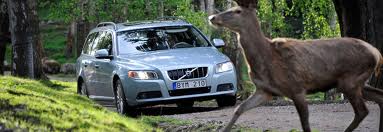Defensive Driving Tip #37: Practice Animal Avoidance!
As we are now into the autumn migratory season, it’s time to talk about defensive driving and wildlife avoidance. Car/animal collisions are a problem across the United States. You might be surprised to learn that over a half million car/animal collisions occur every year! While deer are the most common animal struck, others, such as elk and moose, can pose greater dangers. They are much larger than deer, and on their tall, spindly legs, they are at a perfect height to roll over your hood and cause serious injuries after striking your windshield. Not surprisingly, the severity of injuries is usually higher if you hit an elk than if you hit a deer.
The most important defensive driving rule is not to hit an animal in the first place. In wildlife country or open range (watch for the warning signs), it’s important to slow down at night so you are able to stop or make last second maneuvers within your well-lighted visual range — over 90% of animal/vehicle collisions occur at night, many near dusk or dawn. Steering is “faster” than braking, but the ability to both steer and brake simultaneously is important. When purchasing a new vehicle, be sure to buy ABS brakes and learn how to use them correctly.
If a moose, elk, or other large animal is standing in the road, don’t honk, think about your defensive driving rules, as he might consider it a rude challenge. Stop for him, and wait patiently while he nonchalantly moves off the road. You’ve never seen anything quite as nonchalant as a bull elk as he moves slooowly off the road. So be patient. If there is room to go very wide around him, you might try that (slowly), but I wouldn’t unless it looked like he was NEVER going to move; I’d wait and let him make the first move. For a doe or a cow, one long blast on the horn may frighten them into moving off the roadway.
Another defensive driving tip is to plan ahead — and wear your seat belts. Use your high-beams whenever you can — they are more likely to cause a reflection in the animal’s eyes that you can see. Know when you are most likely to encounter wildlife — early morning, dusk, and at the times of year when the animals are moving from summer to winter grazing areas (or back).
If an animal bounds out in front of you, don’t swerve immediately, but brake as quickly as possible. This will allow the deer (or whatever it is) to move out of the way. If you swerve, he may run into you as you do it. Also, where there is one animal, there are likely to be more, so be careful about looking around for others. Don’t fixate on one and hit another! Finally, if you do hit an animal, don’t get close to it or touch it; doing so could result in a sudden move by the animal, and you could be seriously injured .
Wildlife isn’t the only four-footed hazard out there! Be wary of areas where livestock may be on the road. In the west, for example, there are many “open range” areas. What’s open range? In short, it means no fences, and the cow has the right of way. You may find Elsie on the highway at any time. Some states may have laws that require you to report if you strike livestock on a roadway, so if you do hit one, be sure to call the local law enforcement agency and let them know. Better to be safe than arrested! Same goes for wildlife — if you hit something large, call it in. Some states have laws that allow the meat to be donated to charity kitchens, orphanages, etc. If you get a ticket take our defensive driving course www.2passdd.com
